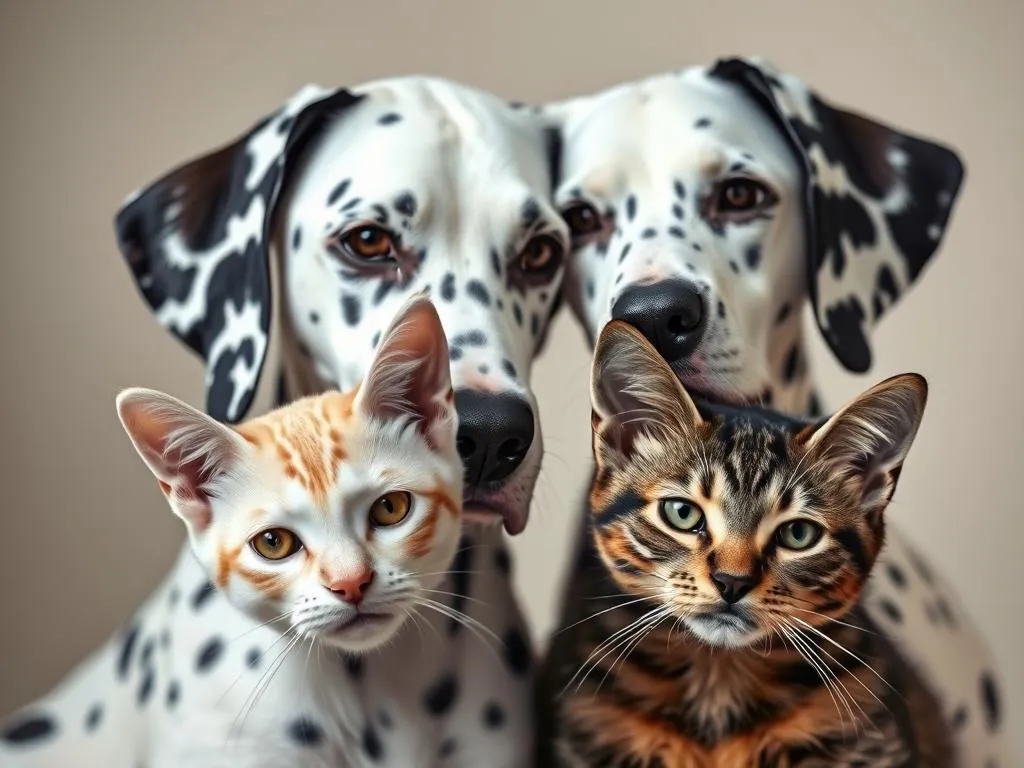
Introduction
Dalmatians have captivated dog lovers for centuries with their striking appearance and lively personalities. Known for their distinctive black or liver-spotted coats, these dogs have become synonymous with firehouses and are often celebrated in popular culture, most notably in Disney’s 101 Dalmatians. However, as potential pet owners consider adding a Dalmatian to their family, a critical question arises: are Dalmatians good with cats?
Understanding the dynamics between dogs and cats is crucial, especially for those looking to create a harmonious multi-pet household. There are many common misconceptions about how these two species interact, which can lead to challenges if not properly addressed. Let’s delve into the world of Dalmatians and cats to uncover their compatibility and what it means for pet owners.
Understanding Dalmatians
Origin and History
The Dalmatian breed has a rich history that dates back hundreds of years. Originally bred in Dalmatia, a historical region of Croatia, Dalmatians served various roles, including as carriage dogs, guard dogs, and firehouse mascots. Their unique combination of strength, endurance, and loyalty made them invaluable in a variety of settings.
Over time, Dalmatians became symbols of protection and service, often seen accompanying firefighters and horse-drawn carriages. Their popularity surged in the 20th century, particularly after the release of 101 Dalmatians, which introduced the breed to a new generation of dog lovers.
Physical Characteristics
Dalmatians are medium-sized dogs, typically weighing between 45 to 70 pounds and standing about 19 to 24 inches tall at the shoulder. Their most distinguishing feature is their short, dense coat adorned with unique spots that can be either black or liver-colored.
A Dalmatian’s lifespan averages around 12 to 15 years, but they are prone to certain health issues, including hip dysplasia and hearing loss. Regular veterinary check-ups and a healthy diet are essential to ensure their well-being.
Temperament and Behavior
Dalmatians are known for their energetic, playful, and friendly nature. They are intelligent dogs that thrive on companionship and enjoy being active. However, this breed can also exhibit some behavioral challenges. Dalmatians may be prone to stubbornness and can become bored easily if not provided with sufficient mental and physical stimulation.
Training is crucial, as these dogs can develop undesirable habits if left unchecked. Consistent obedience training and socialization from a young age are vital to bringing out the best in a Dalmatian.
Understanding Cats
General Cat Behavior
Cats are often perceived as independent creatures, but they possess a complex array of behaviors driven by their instincts. They are territorial animals that rely on scent marking to establish their space. Understanding cat behavior is critical for ensuring a peaceful coexistence with dogs, particularly Dalmatians.
Cats communicate primarily through body language, vocalizations, and scent. They are social animals but have their own social structure, which can vary by breed and individual personality. Some cats are more accepting of dogs than others, often depending on their early socialization experiences.
Cat Breeds
While domestic cats share many common traits, different breeds can exhibit distinct characteristics. For example, a Siamese cat is known for its vocal nature and sociability, while a Maine Coon is generally more laid-back and friendly. Understanding the specific traits of a cat breed can significantly affect how they interact with dogs.
When considering the question of are Dalmatians good with cats, it’s essential to take into account the specific personality and breed of the cat involved.
Assessing Compatibility: Dalmatians and Cats
Factors Influencing Compatibility
The compatibility between Dalmatians and cats is not solely determined by the species itself but rather by individual temperament and experiences. Several factors influence how well these two animals can coexist:
-
Individual Temperament of the Dalmatian: Some Dalmatians may have a higher prey drive, making them less suitable for a home with cats. Others may be more easygoing and friendly.
-
Personality and Behavior of the Cat: A confident and social cat may handle the presence of a dog better than a timid or fearful one.
-
Age and Socialization Experiences: Puppies are generally easier to socialize with cats compared to older dogs, as they are more adaptable and open to new experiences.
Socialization and Training Tips
Early socialization is essential for Dalmatians to cohabit peacefully with cats. Introducing a Dalmatian to a cat should be done gradually and under controlled circumstances. Here are some techniques to aid in their integration:
-
Controlled Introductions: Start by allowing them to sniff each other through a barrier, such as a baby gate or a cracked door. Gradually allow them to interact while supervised.
-
Positive Reinforcement: Use treats and praise to reward both the Dalmatian and the cat for calm behavior during their interactions.
-
Training Commands: Teach the Dalmatian basic commands such as “leave it” or “stay” to help manage their excitement around the cat.
-
Safe Spaces for the Cat: Ensure that the cat has safe areas to retreat to where the dog cannot access. This gives the cat a sense of security.
By following these strategies, you can improve the chances of a harmonious relationship between your Dalmatian and cat.
Real-Life Experiences
Success Stories
Many pet owners have successfully integrated Dalmatians and cats into their homes, sharing heartwarming anecdotes of their pets living together in harmony. For instance, one owner reported that their Dalmatian, after a few weeks of careful introductions, became the best friend of their resident cat, often seen playing together and cuddling on the couch.
Having both pets can bring a wealth of joy to a household. Owners often note that the companionship between the two can lead to playful interactions and a more lively home environment.
Challenges and Solutions
While success stories abound, some challenges may arise when integrating Dalmatians and cats. Aggressive behavior from either party can lead to stress and potential injury.
Some common challenges include:
-
Prey Drive: Dalmatians may chase cats due to their instinctual prey drive.
-
Territorial Aggression: Cats may react defensively when a dog invades their space.
To mitigate these issues, owners can implement the following solutions:
-
Supervised Interactions: Always supervise the initial interactions until a bond is established.
-
Gradual Exposure: Slowly increase the time they spend together to allow both pets to adjust.
-
Redirecting Energy: Provide plenty of physical exercise for the Dalmatian to reduce excess energy that can lead to chasing.
Expert Opinions
Veterinarian Insights
Veterinarians emphasize the importance of understanding both species’ behaviors and health considerations. They recommend ensuring that both pets are healthy and up to date on vaccinations, as this can prevent stress-related health issues.
Additionally, it’s crucial to observe body language. Signs of stress in cats might include hissing, swatting, or hiding, while Dalmatians may bark excessively or display hyperactive behavior. Recognizing these signs can help owners take appropriate action before things escalate.
Trainer and Behaviorist Recommendations
Professional trainers and behaviorists often highlight the value of training and socialization. They stress that teaching your Dalmatian basic obedience commands can be a game-changer in managing interactions with cats.
They also recommend using positive reinforcement techniques to create a positive association between the two pets. Resources such as training classes or behavior consultations can provide further guidance for pet owners.
Conclusion
In summary, the question of are Dalmatians good with cats does not have a one-size-fits-all answer. Compatibility largely depends on individual temperaments, socialization experiences, and the dynamics of the household. With proper training, gradual introductions, and a keen understanding of each pet’s needs, Dalmatians and cats can coexist harmoniously.
As responsible pet owners, it’s essential to consider not just the breed but the personalities of both the Dalmatian and the cat. By fostering an environment of patience and understanding, you can create a loving home for both of your furry companions.
FAQs
-
Can Dalmatians and cats live together?
Yes, with proper introductions and training, many Dalmatians and cats can live together successfully. -
What if my Dalmatian shows aggression toward my cat?
Consult with a professional trainer or behaviorist to address aggressive behavior and create a plan for better interactions. -
Are certain cat breeds more compatible with Dalmatians?
Generally, more social and confident cat breeds may adapt better to living with Dalmatians. -
How can I help my Dalmatian adjust to a new cat?
Gradual introductions, positive reinforcement, and ensuring safe spaces for the cat can help ease the transition.









